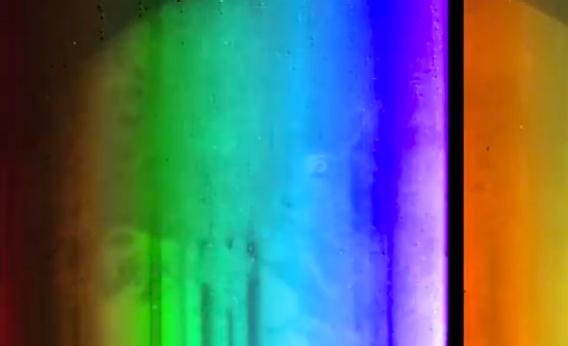Create a free profile to get unlimited access to exclusive videos, sweepstakes, and more!
Stained Glass Pluto

This is pretty amazing: An actual movie taken by a camera on board the New Horizons spacecraft as it passed by Pluto in July! But it’s not your ordinary movie … it’s actually taking a spectrum of Pluto, mapping out minerals on its surface as the world sweeps by underneath. The spectrum is in the infrared, light invisible to our eyes, but it’s been converted to colors our eyes can see to produce this trippy and very cool video:
So what the heck did you just see? First, let me link to Alex Parker's write-up of this; Parker created the video and gives loads of details. But I can't resist explaining it myself; it's too much fun not to.
The detector used to make this is called LEISA, for Linear Etalon Imaging Spectral Array. It’s a small 256 x 256 pixel detector, and it’s equipped with a very weird filter. Usually, filters are flat and let through a very specific wavelength, or color, of light.
But LEISA has a wedge filter, and this means that different wavelengths are let through at different positions on the filter. In this case, you get slices of color, so the "bluest" (shortest wavelength) light gets through on one side of the filter, the "reddest" (longest wavelength) at the other, with a gradual series of steps in between. That’s why you see those vertical slices of color: Each is one of 256 individual slices of color the filter lets through.
In this case, the light is infrared, with 1.25 micron light on the left and 2.5 microns on the right. The human eye can see out to about .75 microns or so, so this IR light is invisible to us, but many minerals can be identified by how much of these colors of light they reflect and absorb. These include water ice, carbon dioxide, nitrogen, and methane.
As the spacecraft moved past Pluto, the tiny icy world swept past the detector. The detector is set up to take images at the same speed Pluto moved past, in a sense taking 256 pictures that could then be split up and reassembled to map the surface in all 256 colors.
I know, that’s weird. Imagine it this way: Let’s say you have a single column of pixels that only lets through light at 1.25 microns. As the detector sees the edge of Pluto it takes a snapshot (creating a single line of data). Then a moment later, it takes another, then another, and so on. Eventually, you have 256 slices of Pluto that will all fit together to make a picture of it.
This is called the pushbroom technique. But why stop with one row of pixels? If you have two, each seeing different colors, you can make two color images at the same time. Or 3, or 4 … or 256. That’s how this works.
In the video, the colors were shifted in wavelength, converted, to blue through red so our eyes can interpret them. Watch it again, and keep your eyes on some particular feature on Pluto’s surface, say, a dark spot. As it moves across the detector, you may see it get brighter and darker. That’s because different minerals (say, water ice versus methane ice) reflect and absorb different colors differently. So one might be very bright in “blue” but very dark in “green.”
The dark vertical streaks correspond to colors where some minerals absorb light. Not as much light from the Sun gets reflected, so that part of the image looks darker. Really strong ones correspond to nitrogen and methane ice, which are abundant on the surface.
It’s interesting how the surface seems very high contrast in the “purple,” and you can see lots of bright and dark features. Clearly, there are some minerals on the surface of Pluto that strongly absorb the infrared light that’s displayed as purple in the video, while others don’t, giving them high contrast (the orange section on the right is a special case; it covers a narrower part of the spectrum at higher color resolution; this part is sensitive to nitrogen, and is used to map temperature and composition variations with more detail).
Also, you can see Pluto moving slightly up and down, bobbing, as it moves across the view. That’s actually due to the New Horizons thrusters firing as it flew by! The individual snapshots were taken about every half-second to create this video, so you’re seeing things sped up, but still, that’s very cool.
As a final note, a reminder that this movie was assembled by Alex Parker, who does simply amazing work with Pluto images. Follow him on Twitter. Trust me: He will drop a bit of true wonder into your timeline every now and again, and your life will be better for it.


























